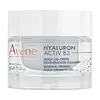Babor Cleanformance Moisture Glow Cream Versus Avène Hyaluron Activ B3 Renewal Firming Aqua Cream-In-Gel
What's inside
What's inside
 Key Ingredients
Key Ingredients

 Benefits
Benefits

 Concerns
Concerns

 Ingredients Side-by-side
Ingredients Side-by-side

Water
Skin ConditioningGlycerin
HumectantPrunus Amygdalus Dulcis Oil
Skin ConditioningPotassium Cetyl Phosphate
EmulsifyingLactococcus Ferment Lysate
Skin ConditioningCetearyl Alcohol
EmollientCocoglycerides
EmollientHydrogenated Palm Glycerides
EmollientHydrolyzed Yeast Protein
Skin ConditioningBeta Vulgaris Root Extract
Skin ConditioningFructooligosaccharides
HumectantVitis Vinifera Seed Oil
EmollientCoco-Caprylate
EmollientPhenoxyethanol
PreservativeMica
Cosmetic ColorantButylene Glycol
HumectantParfum
MaskingPotassium Lactate
BufferingPentylene Glycol
Skin ConditioningEthylhexylglycerin
Skin ConditioningLactic Acid
BufferingHelianthus Annuus Seed Oil
EmollientSodium Hyaluronate
HumectantTocopherol
AntioxidantLinalool
PerfumingBiosaccharide Gum-1
HumectantBenzyl Alcohol
PerfumingSodium Hydroxide
BufferingBenzyl Salicylate
PerfumingSodium Chloride
MaskingAcer Rubrum Bark Extract
Skin ConditioningSodium Benzoate
MaskingGeraniol
PerfumingCI 77891
Cosmetic ColorantWater, Glycerin, Prunus Amygdalus Dulcis Oil, Potassium Cetyl Phosphate, Lactococcus Ferment Lysate, Cetearyl Alcohol, Cocoglycerides, Hydrogenated Palm Glycerides, Hydrolyzed Yeast Protein, Beta Vulgaris Root Extract, Fructooligosaccharides, Vitis Vinifera Seed Oil, Coco-Caprylate, Phenoxyethanol, Mica, Butylene Glycol, Parfum, Potassium Lactate, Pentylene Glycol, Ethylhexylglycerin, Lactic Acid, Helianthus Annuus Seed Oil, Sodium Hyaluronate, Tocopherol, Linalool, Biosaccharide Gum-1, Benzyl Alcohol, Sodium Hydroxide, Benzyl Salicylate, Sodium Chloride, Acer Rubrum Bark Extract, Sodium Benzoate, Geraniol, CI 77891
Water
Skin ConditioningGlycerin
HumectantNiacinamide
SmoothingSqualane
EmollientDiglycerin
HumectantPersea Gratissima Oil
Skin ConditioningHydroxyethyl Acrylate/Sodium Acryloyldimethyl Taurate Copolymer
Emulsion StabilisingPolyglyceryl-10 Myristate
Skin ConditioningSodium Hyaluronate
Humectant1,2-Hexanediol
Skin ConditioningBehenyl Alcohol
EmollientCaprylic/Capric Triglyceride
MaskingCaprylyl Glycol
EmollientCaramel
Cosmetic ColorantCitric Acid
BufferingParfum
MaskingPolysorbate 60
EmulsifyingSodium Citrate
BufferingSorbitan Isostearate
EmulsifyingTocopheryl Glucoside
EmollientXanthan Gum
EmulsifyingWater, Glycerin, Niacinamide, Squalane, Diglycerin, Persea Gratissima Oil, Hydroxyethyl Acrylate/Sodium Acryloyldimethyl Taurate Copolymer, Polyglyceryl-10 Myristate, Sodium Hyaluronate, 1,2-Hexanediol, Behenyl Alcohol, Caprylic/Capric Triglyceride, Caprylyl Glycol, Caramel, Citric Acid, Parfum, Polysorbate 60, Sodium Citrate, Sorbitan Isostearate, Tocopheryl Glucoside, Xanthan Gum
Ingredients Explained
These ingredients are found in both products.
Ingredients higher up in an ingredient list are typically present in a larger amount.
Glycerin is already naturally found in your skin. It helps moisturize and protect your skin.
A study from 2016 found glycerin to be more effective as a humectant than AHAs and hyaluronic acid.
As a humectant, it helps the skin stay hydrated by pulling moisture to your skin. The low molecular weight of glycerin allows it to pull moisture into the deeper layers of your skin.
Hydrated skin improves your skin barrier; Your skin barrier helps protect against irritants and bacteria.
Glycerin has also been found to have antimicrobial and antiviral properties. Due to these properties, glycerin is often used in wound and burn treatments.
In cosmetics, glycerin is usually derived from plants such as soybean or palm. However, it can also be sourced from animals, such as tallow or animal fat.
This ingredient is organic, colorless, odorless, and non-toxic.
Glycerin is the name for this ingredient in American English. British English uses Glycerol/Glycerine.
Learn more about GlycerinParfum is a catch-all term for an ingredient or more that is used to give a scent to products.
Also called "fragrance", this ingredient can be a blend of hundreds of chemicals or plant oils. This means every product with "fragrance" or "parfum" in the ingredients list is a different mixture.
For instance, Habanolide is a proprietary trade name for a specific aroma chemical. When used as a fragrance ingredient in cosmetics, most aroma chemicals fall under the broad labeling category of “FRAGRANCE” or “PARFUM” according to EU and US regulations.
The term 'parfum' or 'fragrance' is not regulated in many countries. In many cases, it is up to the brand to define this term.
For instance, many brands choose to label themselves as "fragrance-free" because they are not using synthetic fragrances. However, their products may still contain ingredients such as essential oils that are considered a fragrance by INCI standards.
One example is Calendula flower extract. Calendula is an essential oil that still imparts a scent or 'fragrance'.
Depending on the blend, the ingredients in the mixture can cause allergies and sensitivities on the skin. Some ingredients that are known EU allergens include linalool and citronellol.
Parfum can also be used to mask or cover an unpleasant scent.
The bottom line is: not all fragrances/parfum/ingredients are created equally. If you are worried about fragrances, we recommend taking a closer look at an ingredient. And of course, we always recommend speaking with a professional.
Learn more about ParfumSodium Hyaluronate is hyaluronic acid's salt form. It is commonly derived from the sodium salt of hyaluronic acid.
Like hyaluronic acid, it is great at holding water and acts as a humectant. This makes it a great skin hydrating ingredient.
Sodium Hyaluronate is naturally occurring in our bodies and is mostly found in eye fluid and joints.
These are some other common types of Hyaluronic Acid:
Learn more about Sodium HyaluronateWater. It's the most common cosmetic ingredient of all. You'll usually see it at the top of ingredient lists, meaning that it makes up the largest part of the product.
So why is it so popular? Water most often acts as a solvent - this means that it helps dissolve other ingredients into the formulation.
You'll also recognize water as that liquid we all need to stay alive. If you see this, drink a glass of water. Stay hydrated!
Learn more about Water